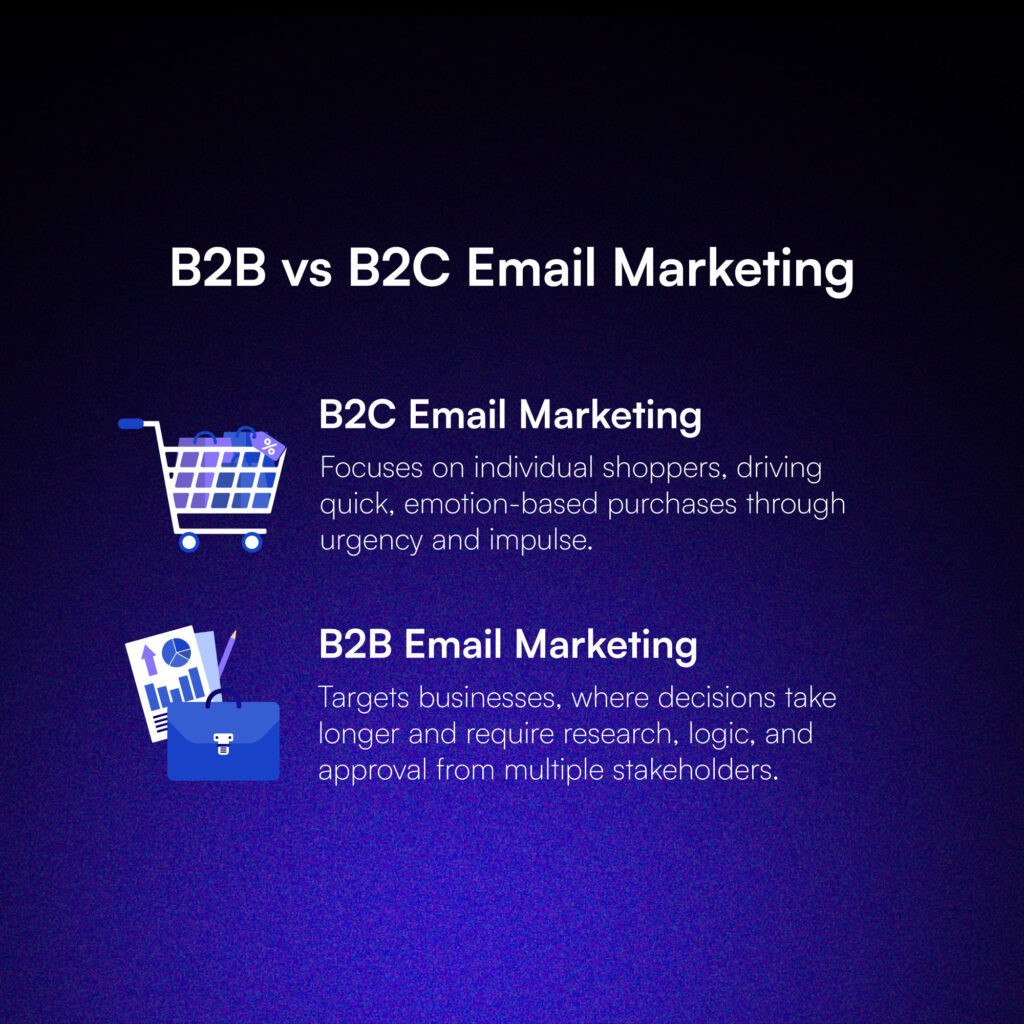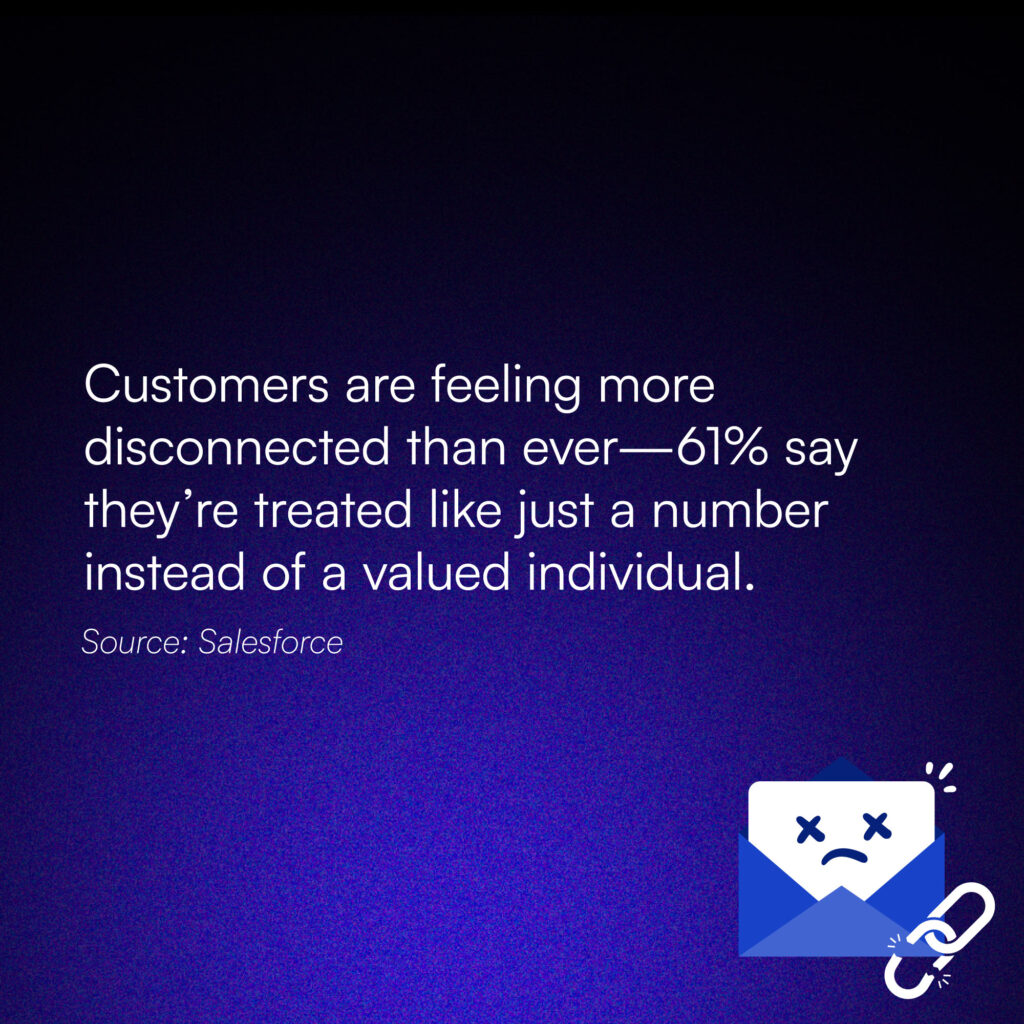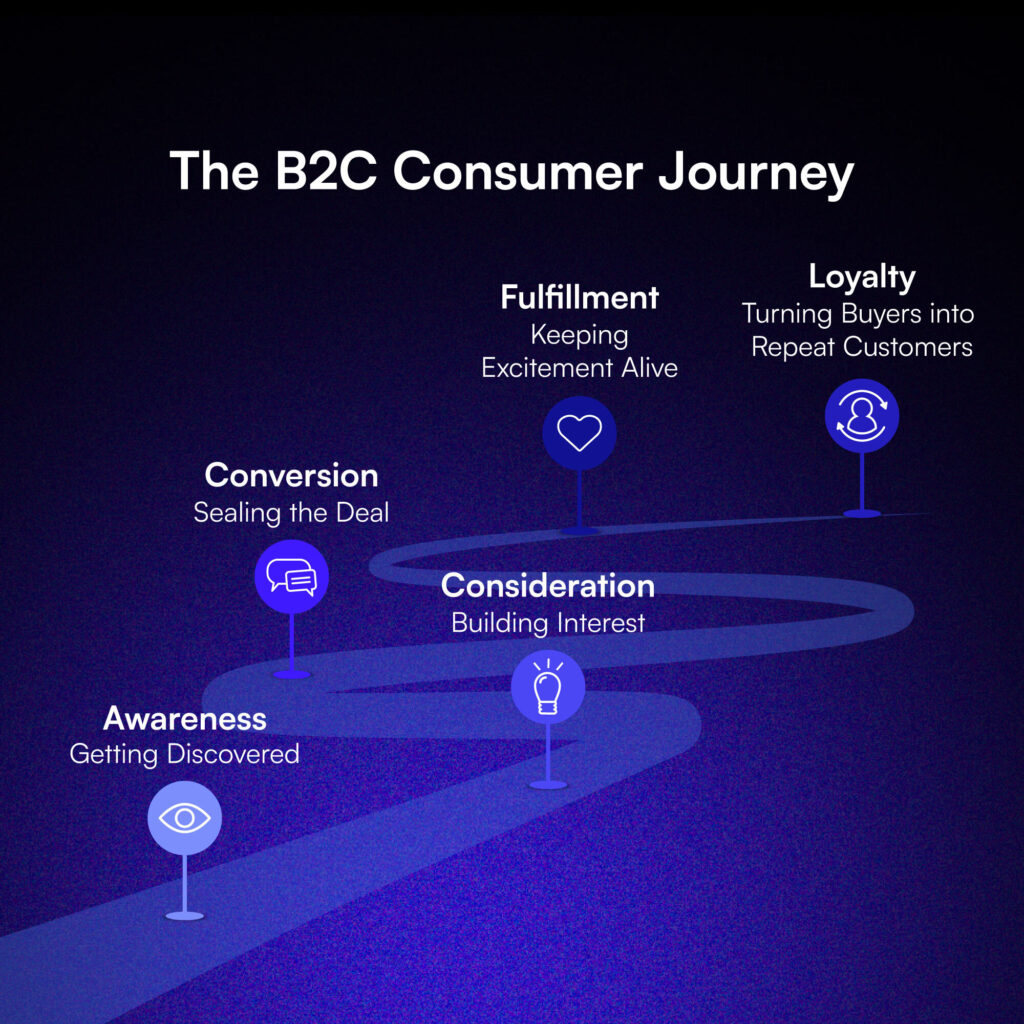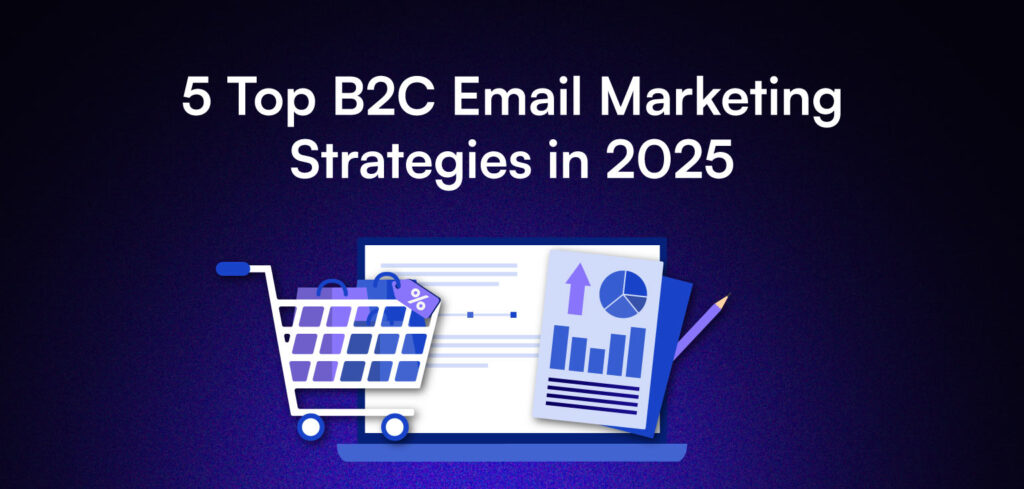B2C email marketing isn’t just about sending out promotions and hoping for sales.
Consumer expectations are sky-high. Amazon has set the bar with one-click checkouts, ultra-fast shipping, and eerily spot-on product recommendations.
Consumers expect personalized, timely, and relevant messages. Anything less, and your emails will get ignored or worse, marked as spam.
Think about it: your inbox is probably flooded with emails you never open. But the ones that grab your attention?
They speak directly to you, offering something valuable at the right moment. That’s what makes an email marketing strategy successful this year.
So, how do you stand out and keep customers coming back?
Let’s break down five top B2C email marketing strategies that will help you increase engagement, boost conversions, and build long-term customer relationships.
What is B2C Email Marketing?
B2C email marketing is all about building a direct connection with consumers and making it easy for them to buy.
Unlike B2B emails that focus on long-term relationships and detailed decision-making, B2C emails are fast, eye-catching, and designed to spark action. Whether it’s a flash sale, a personalized product recommendation, or a reminder about an abandoned cart, these emails nudge customers toward making a purchase—often on impulse.
The goal? To make shopping feel exciting, effortless, and maybe even a little irresistible.
Think of business-to-consumer marketing examples like Apple launching a new iPhone with sleek ads, or Nike dropping limited-edition sneakers that sell out in minutes.
These brands don’t just sell—they create experiences.
A well-timed email with a limited-time offer or a personalized discount can turn a casual browser into a paying customer in seconds. It’s about creating moments that grab attention and make people feel like they’re getting something special.
So, first, let’s compare it to B2B email marketing.
B2B vs B2C Email Marketing: What’s the Difference?
At first glance, the difference between B2C (business-to-consumer) and B2B (business-to-business) marketing seems pretty obvious. B2C targets shoppers, while B2B targets businesses.
But the way these strategies work? That’s a whole different story.
With B2C, it’s all about fast, emotion-driven decisions. Think about someone scrolling through Instagram, seeing a “limited-time offer,” and buying something without a second thought. That’s the power of B2C—quick, on-the-spot purchases.
On the flip side, B2B is a much slower game. It’s about logic, research, and getting buy-in from a whole team. For example, an online store looking to purchase bulk supplies of energy drinks or shampoos. They might spend months comparing options, reading reviews, and having meetings before finally making a decision.

Disecting B2B and B2C Email Marketing
So, to really crush it in either world, you need to fully understand them to create the right game plan.
1. Sales Cycle Speed: B2C purchases happen fast—often on impulse. B2B sales? They involve multiple decision-makers and can take months.
2. Content Style: B2B marketing leans on in-depth reports and case studies. B2C marketing strategies focus on emotional, engaging content—think TikTok videos, Instagram Reels, and viral tweets.
3. Promotion Channels: B2B brands thrive on LinkedIn and email. B2C brands need an omnichannel strategy, including Google Search, TikTok, Instagram, and email marketing.
4. Customer Loyalty: B2B companies rely on contracts and subscriptions. B2C brands need loyalty programs, personalized offers, and exceptional customer service to keep people coming back.
5. Key Metrics: B2B tracks ROI and cost savings. B2C marketing success depends on engagement, conversions, and repeat customers.
The Top 5 B2C Email Marketing Strategies in 2025
Now, let’s uncover the 5 powerful B2C email marketing strategies that will help you connect with your audience, drive engagement, and increase conversions in 2025.
1. Personalization at Scale: Make Every Email Feel One-on-One

Personalization isn’t just a trend—it’s more important than ever. But it’s not all about using a first name in the subject line.
We’re talking real, meaningful personalization. Think dynamic content, personalized product suggestions, and emails triggered by what your customers do.
Here’s how:
- Segment Your Audience: Use data to divide your subscribers into smaller groups based on their interests, purchase history, and behavior. HubSpot and Mailchimp make this process seamless.
- Leverage AI-Powered Recommendations: Platforms like Klaviyo and ActiveCampaign analyze past behavior to suggest products that match a user’s preferences.
- Use Dynamic Content Blocks: This allows you to create a single email template that displays different content for different users. Campaign Monitor has robust features for this.
Example: Personalization Done Right
Let’s say you run an online fashion store. Instead of sending a generic email about your new arrivals, you send:
- To past buyers of sneakers: “Hey Alex, these new kicks just dropped, and we think you’ll love them!”
- To someone who browsed jackets but didn’t buy: “Still thinking about that leather jacket? Here’s 10% off to help you decide!”
See the difference? Instead of a mass email, each person gets something relevant to them—and that’s what drives engagement.
2. Exclusive VIP Offers and Loyalty Programs
Want to keep your best customers coming back? Offering VIP perks and loyalty rewards is one of the best ways to build lasting relationships with your subscribers.
When done correctly, these programs not only boost engagement but also increase customer lifetime value (CLV).
Here’s what’s working now:
- Early Access to Sales – Reward your VIP customers with exclusive early-bird access to major sales. This makes them feel valued and increases urgency. Brands like Sephora, their Sephora’s Beauty Insider program successfully use this strategy to keep customers engaged.
- Tiered Loyalty Programs – Give repeat customers points for purchases, referrals, or even engagement with your emails. Platforms like Smile.io make this easy by offering customizable rewards programs for eCommerce brands.
- Exclusive Member-Only Discounts – Offer special discount codes or perks for VIP subscribers who have spent a certain amount or have been on your list for a while. Ulta Beauty is a great example of a successful tiered loyalty system that rewards customers with personalized perks.
Example: A VIP Club That Drives Sales
A fashion brand sends an email with the subject line, “VIPs Get First Dibs to Our Summer Collection.”
The email includes a special link where their best customers can shop the collection 24 hours before everyone else.
Why it works: VIP customers feel special and appreciated, and the brand generates early sales before the main launch. It’s a simple yet powerful way to boost revenue and customer loyalty while making subscribers feel like they’re part of an exclusive club.
3. Omnichannel Integration: Keep the Conversation Going Everywhere
Your customers don’t just check email—they scroll Instagram, shop online, and browse TikTok. That means your email marketing shouldn’t exist in a vacuum—it should seamlessly connect with your other channels.
- Sync Email & Social Media – Retarget email subscribers with personalized ads on Facebook and Instagram.
- Use SMS & Push Notifications – If someone abandons their cart after clicking an email, follow up with a quick SMS reminder. Platforms like Postscript integrate email with SMS for better results.
- Leverage Website Popups & Chatbots – Capture leads from your website and enroll them into personalized email sequences using Drift.
Example: Omnichannel in Action
A clothing brand sends an email about an exclusive flash sale. The recipient opens it but doesn’t purchase. Later, they see an Instagram ad featuring the same product. Still hesitant? A push notification pops up with “Hurry! Only a few left in stock.”
Multiple touchpoints, one seamless shopping experience. That’s omnichannel done right.
4. AI-Powered Automation: Work Smarter, Not Harder
Let’s be honest: manually sending emails is exhausting. That’s why automation is non-negotiable in 2025.
AI-driven email sequences ensure your subscribers get the right message at the right time—without you lifting a finger.
- Welcome Series – Automatically introduce new subscribers to your brand and best-selling products.
- Cart Abandonment Emails – Remind customers about what they left behind. Adding a small discount often seals the deal.
- Re-Engagement Campaigns – If someone hasn’t opened your emails in months, send a “We Miss You” email with a special offer.
- AI-Powered Send Time Optimization – Tools like Mailchimp analyze when each subscriber is most likely to open their email and send it at the perfect moment.
Example: Automated Cart Recovery
A customer adds a pair of jeans to their cart but doesn’t check out.
- 24 hours later: They get an email: “Forget something? Your jeans are still in your cart!”
- 3 days later: Another reminder with a 10% discount.
- 1 week later: A final email with social proof: “500+ happy customers love these jeans! Don’t miss out.”
And just like that, automation turns abandoned carts into sales.
5. User-Generated Content (UGC): Let Your Customers Market for You
People trust other customers more than they trust brands. That’s why user-generated content (UGC) is gold for B2C email marketing.
- Feature Customer Photos & Reviews – Include real images and testimonials from happy customers.
- Incentivize UGC – Offer discounts to customers who share their purchases on social media.
- Turn UGC into Shoppable Emails – Link customer photos to product pages for easy shopping.
Example: UGC That Sells
A fitness brand sends an email featuring a “Customer Spotlight,” showcasing real people using their products. Each testimonial includes a photo, a short review, and a direct link to the product page.
Why does this work?
- Builds trust – Seeing real customers using the product feels more authentic than brand promotions.
- Creates social proof – If others love it, new shoppers are more likely to buy.
- Reduces friction – A direct link makes purchasing quick and easy.
The B2C Consumer Journey: How People Buy Today
To win in B2C, you need to understand how consumers shop in 2025. Here’s the modern B2C customer journey and what you should do at each stage.

1. Awareness: Getting Discovered
It all starts when someone realizes they need something—like new sneakers or a skincare routine.
Where do they look?
- Google: SEO-optimized content helps you rank for relevant searches.
- TikTok: Over 40% of Gen Z use TikTok as a search engine.
- Instagram & Facebook Ads: Social proof (likes, shares, comments) builds trust.
Pro tip: Run influencer partnerships and user-generated content campaigns to boost discovery.
2. Consideration: Building Interest
At this point, shoppers compare brands, check prices, and read reviews.
They might:
- Browse your site
- Sign up for emails or SMS
- Follow you on social media
B2C ecommerce best practices: Offer first-time discounts, free shipping, or exclusive access to VIP sales.
3. Conversion: Sealing the Deal
Some shoppers buy instantly, but others hesitate. Here’s where abandoned cart emails, SMS reminders, and limited-time offers can push them over the edge.
Example: 50% of consumers expect brands to offer discounts or special deals before making a purchase.
4. Fulfillment: Keeping Excitement Alive
Once they buy, they expect instant order confirmations and tracking updates.
B2C ecommerce best practices include:
- Personalized thank-you emails
- Product guides or tutorials
- Hassle-free returns
5. Loyalty: Turning Buyers into Repeat Customers
Body Text, do not delete, duplicate me
Don’t Just Blend In—Stand Out!
B2C email marketing is always evolving, and the key to grabbing attention is making your emails feel personal and truly engaging.Whether you’re using AI to automate smarter, connecting across multiple channels, or letting your customers create content, the goal is simple.
Send emails that actually matter to your audience.
Try these strategies and see the difference in your engagement and sales. Need a hand fine-tuning your email marketing?


